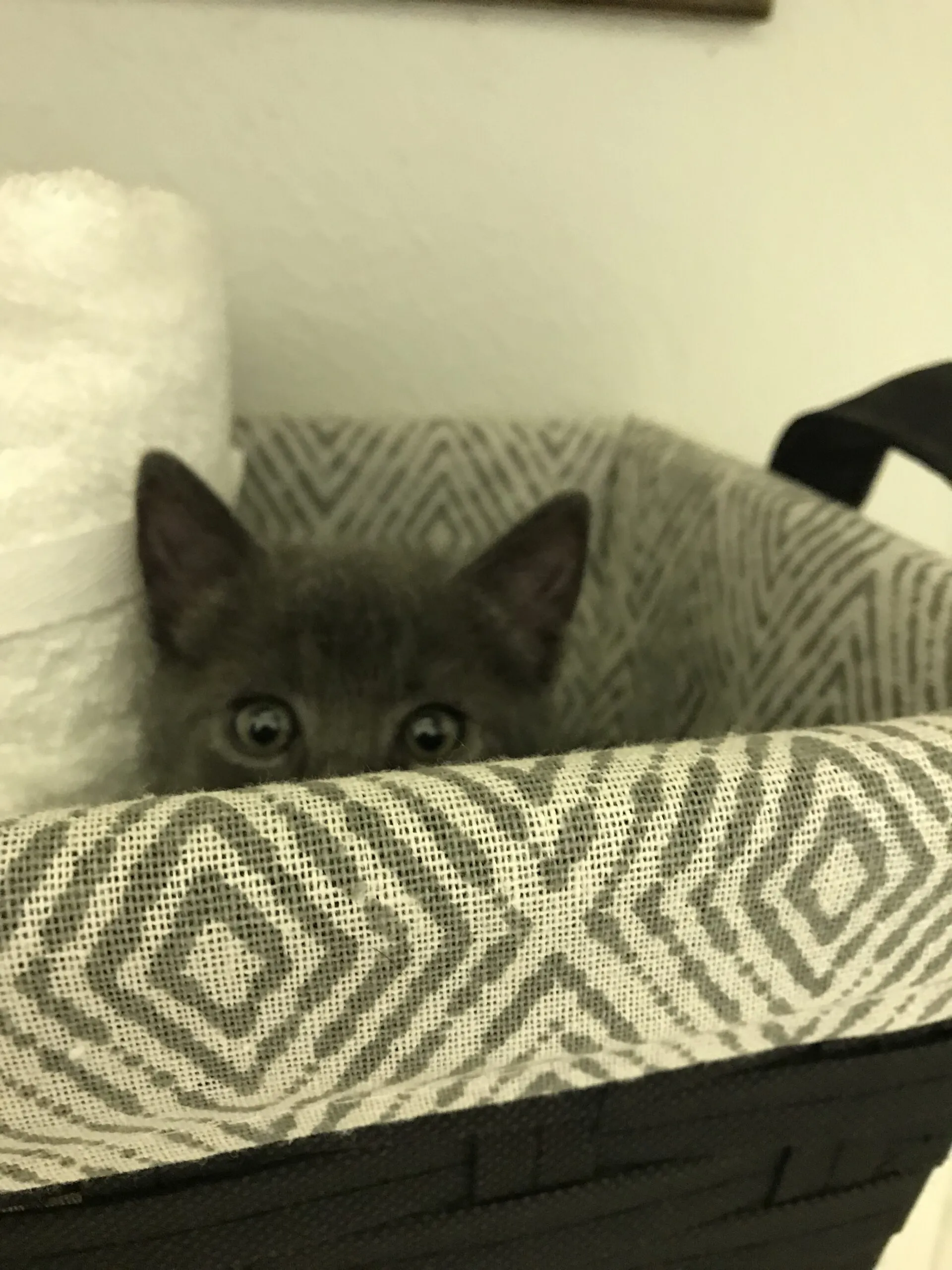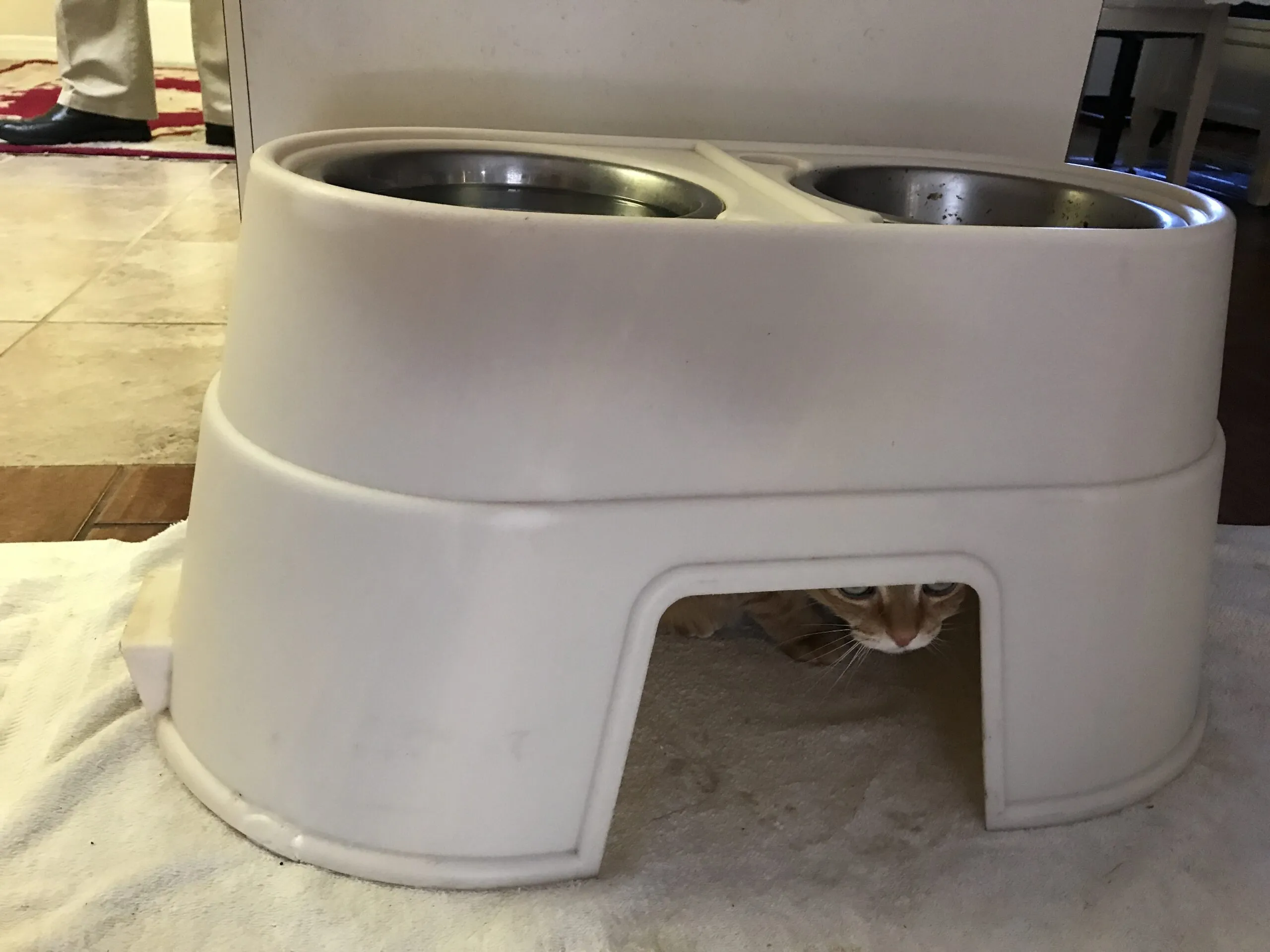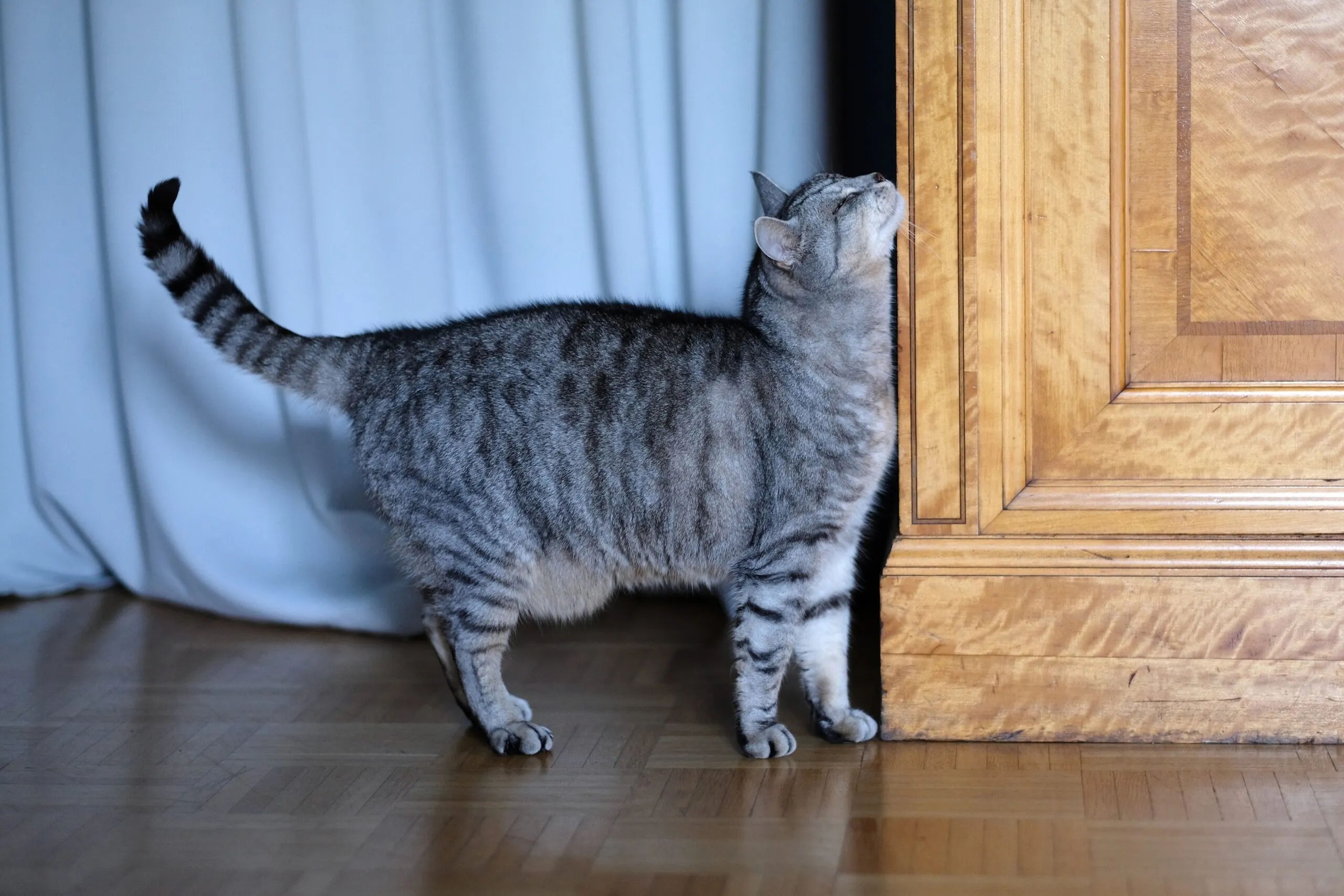Bringing a new cat home is an exciting time, filled with dreams of cuddles and playful antics. Yet, for many new cat owners, this joyful anticipation can quickly turn into concern when their new feline friend immediately retreats, often disappearing under the bed, behind furniture, or into the darkest corners of the house. If you’re wondering “why is my New Cat Hiding Under Bed?” and what you can do to help, rest assured that this behavior is entirely normal and a common part of a cat’s adjustment process. Understanding their instincts and providing a supportive environment can make all the difference in helping your shy new companion blossom into a confident family member. Often, a new cat hiding under bed or in a dark corner is simply overwhelmed, not engaging in playful chase like you might observe when chasing a cat in a safe, familiar environment.
Patience is Key: Letting Your New Cat Acclimate
One of the most crucial things to remember when your new cat is hiding is to practice extreme patience. For a kitty in a new or unfamiliar environment, hiding is a healthy and completely normal reaction. When you first met your cat at the shelter or previous home, they were in familiar territory, surrounded by scents and sights they knew. Now, they are in an entirely new world, and their instinct is to seek safety and observe from a secure spot.
Do not try to force your new cat out from under the bed or any other hiding place. Reaching in and attempting to pull them out will only increase their fear and anxiety, making them less likely to trust you. Instead, give them ample time to adjust to their new surroundings on their own terms. Cats are highly territorial animals, and they will feel unsettled until they believe this new space is truly their home. It doesn’t look like “home,” and, more importantly for your new kitty, it doesn’t smell like home. It may even carry the scents of previous pets or unknown humans.
 A small cat peeking out from under a wooden basket, looking cautious in a new environment.
A small cat peeking out from under a wooden basket, looking cautious in a new environment.
They need time to understand that they are safe. You’ll know they’re starting to feel at home when they begin marking their territory. Cats have scent glands primarily on their forehead, cheeks, and chin. They will rub against objects—and eventually you—to spread their unique scent, effectively claiming their space and expressing comfort. This “head-butt” or cheek rub is their way of saying, “This is mine. This is safe.” Once they feel safe and a little braver, your kitty should start to come out and explore, marking the house—and you—with their scent to establish that, “Yes, this is my house, and you are my human!”
Identifying and Reducing Potential Stressors
While a new cat hiding under the bed is often just a temporary phase, it’s essential to observe if the hiding behavior persists for an extended period, or if your cat seems too frightened to even venture out for food or water. If this is the case, you should start looking for things in your home that your new kitty might perceive as a threat.
Consider the environment from a cat’s perspective. Are there a lot of people constantly coming and going? Loud guests, boisterous children, or other pets can be incredibly intimidating for a shy new feline. The volume of your television, a noisy air conditioning unit, or even unfamiliar smells can trigger anxiety and keep your cat in hiding. Take a moment to assess the noise levels and activity in the room where your cat is hiding. Is there a chiming grandfather clock, a barking dog, or a constantly running vacuum cleaner that might be overwhelming your sensitive new companion?
Cats are incredibly sensitive to their surroundings. What might seem like a minor disturbance to us, such as a sudden loud noise, can be a major stressor for a new cat trying to acclimate. Reducing these environmental stressors can significantly help your new cat feel more secure. This might involve keeping visitors to a minimum for the first few days, ensuring children are calm and gentle around the new pet, or simply turning down the volume of electronics. Creating a calm and predictable environment will provide the reassurance your cat needs to eventually emerge from their hiding spot and explore their new domain.
Ensuring Your Cat Feels Secure, Not Trapped
Even the most confident cats have an innate need to know where the nearest escape route is. This instinct for self-preservation is heightened in a new cat who is still feeling vulnerable in an unfamiliar home. If your new cat has taken to hiding under the bed or behind a closet door, it’s crucial to ensure they don’t feel trapped in their chosen spot or in any room.
Always leave doors open to rooms where your cat is located, and never block their exits. Creating an open and accessible environment allows them the freedom to explore when they feel ready, and to retreat to safety if they become overwhelmed. A cat that feels trapped will be far more anxious and less likely to venture out. Imagine being in a new, unfamiliar place with no clear way out—it would be stressful for anyone. Your cat feels the same way. By providing clear pathways and open spaces, you are subtly communicating to your cat that they have control over their environment, which is a powerful tool in building their confidence and trust.
 A shy cat is peeking out from a dark hiding spot, with its eyes wide, indicating fear or uncertainty.
A shy cat is peeking out from a dark hiding spot, with its eyes wide, indicating fear or uncertainty.
Beyond just leaving doors open, consider the overall layout of the room. Are there other accessible hiding spots that are less extreme than under the bed? Providing multiple safe havens, such as cardboard boxes, cat trees with enclosed perches, or even open-front carriers, can give your cat options and help them feel more in control. These alternative hiding spots can encourage them to move around the room more freely, knowing that a safe retreat is always within reach. This approach gently coaxes them out without forcing them, fostering a sense of security that is vital for their long-term adjustment.
Positive Reinforcement: Encouraging Interaction
While patience is paramount, you can also actively encourage your new cat to come out from under the bed by reinforcing positive behaviors. A little positive encouragement goes a long way, even with the shyest felines. One effective method is to use toys to entice them. Most kitties can’t resist something small and moving near them, sparking their natural hunting instincts.
Try using a wand toy with something dangling from a long string. This allows you to interact with your cat from a distance, giving them the space they need to feel safe while still engaging their curiosity. Wiggle the toy near their hiding spot, allowing them to bat at it from a secure position. Gradually, you can move the toy further away, encouraging them to take a few steps out.
In addition to playtime, treats are an excellent way to create positive associations. Have some delicious, high-value treats on hand to offer any time your cat takes a step towards you or ventures a little further out into the open. You can also leave a few treats just outside their hiding place. If they poke their head out to snatch a treat, resist the urge to rush towards them. What would you do if you were scared and someone suddenly rushed at you? You’d run and hide. Let them know you aren’t a threat; let them come to you on their own terms. This subtle encouragement builds trust and reinforces the idea that being near you and being in the open can lead to rewarding experiences.
Strategic Placement of Essentials (Food, Water, Litter)
When your new cat is hiding under the bed, they might be too afraid to venture out even for basic necessities like food, water, and the litter box. This can become a serious health concern if they go too long without eating, drinking, or eliminating. It’s also important to consider if another pet, even unintentionally, is blocking access to these vital resources.
Initially, it can be highly beneficial to place their food, water, and a litter box just outside of their primary hiding spot. This ensures they have easy access to these essentials without having to overcome their fear of venturing into open, unfamiliar territory. While this encourages them to poke out a bit, it won’t force them further than they feel comfortable with. Over time, as your cat gains confidence and starts to explore more, you can gradually move these items closer to their permanent designated locations.
 A close-up shot of a cat's chin, emphasizing the scent glands located there, as it rubs against a surface.
A close-up shot of a cat's chin, emphasizing the scent glands located there, as it rubs against a surface.
When moving these items, do so incrementally—a few feet each day or every couple of days. Observe your cat’s behavior; if they seem hesitant to follow, slow down the relocation process. The goal is to gently guide them into becoming more comfortable with their new home environment, rather than startling them into deeper hiding. With a little patience and consistent encouragement, your new cat will feel safe enough to come out, start exploring the entire house, and comfortably use their designated feeding and litter areas. This methodical approach minimizes stress and reinforces their sense of security.
Creating a Dedicated Safe Haven
Just like humans need their own private spaces, your new cat needs a dedicated safe haven—a place they can call their own, retreat to, and feel completely secure. You have a bedroom, and other family members likely have their own spaces, too. Your new kitty should have a similar sanctuary.
Creating a comfortable, safe space for them to escape to is a fabulous way to help your new kitty feel at home. This dedicated territory will boost their confidence and encourage their bravery over time. Be creative in setting up this space. A good kitty safe space should include a comfy bed, perhaps a soft blanket that smells like you (if they’ve rubbed against it), a few favorite toys, and it should be located in a quiet, low-traffic area of the house. Providing some seclusion, perhaps in a spare room or a quiet corner of a less-used room, is an excellent way to give them a sense of security and help them adjust without constant exposure to household hustle and bustle.
This personal territory isn’t meant to be a permanent hiding spot but rather a launchpad for exploration. From this secure base, your cat can gradually venture out, knowing they have a dependable retreat whenever they feel overwhelmed. In no time, you’ll likely see them venturing out from their safe haven to start exploring the rest of the house, eventually making themselves comfortable in every room and no longer needing to rely on hiding under the bed. This gradual introduction empowers them to embrace their new home at their own pace.
Bringing Your Hiding Cat Out of Their Shell
Bringing home a new cat is a journey of discovery, and finding your new cat hiding under the bed is often just the first step in helping them adapt. Remember, your new kitty is simply reacting naturally to an overwhelming situation. They need patience, understanding, and a carefully crafted environment that fosters a sense of security. By following these guidelines—being patient, identifying stressors, ensuring escape routes, using positive reinforcement, strategically placing essentials, and providing a safe haven—you are building a foundation of trust and comfort. With a little time and a lot of love, you will soon be snuggling with your confident fur baby, enjoying those long, special hours together, just like you always dreamed.
